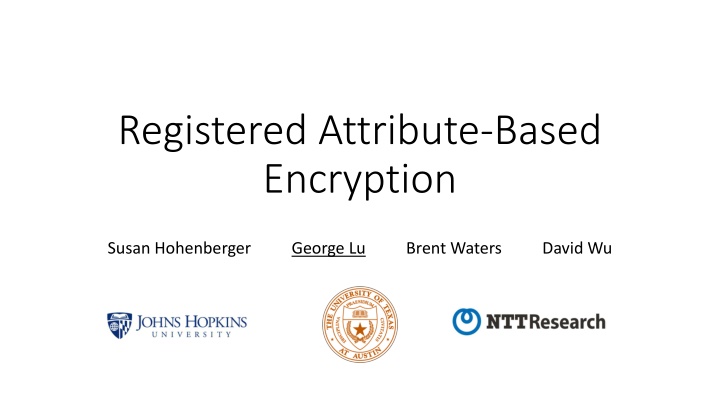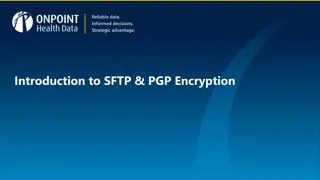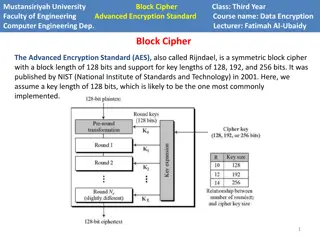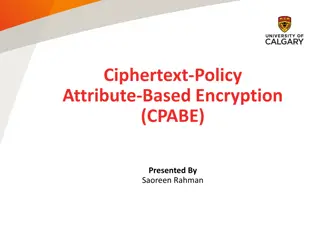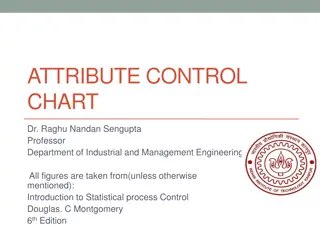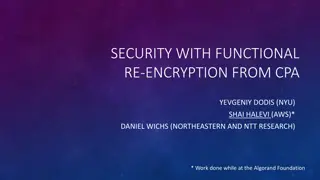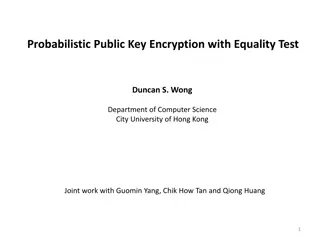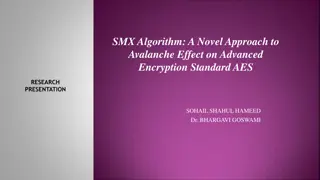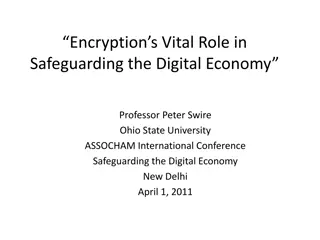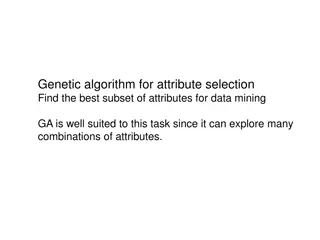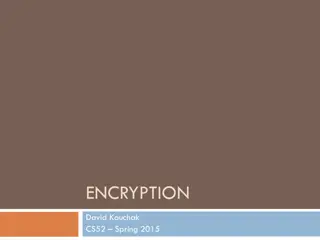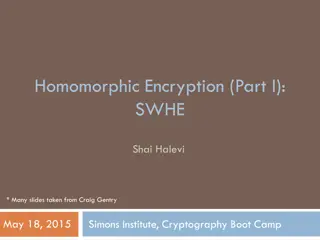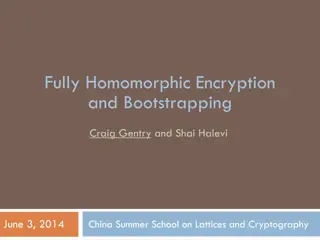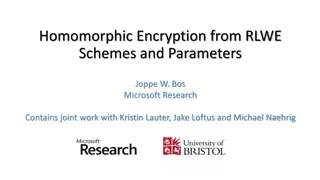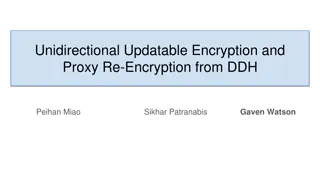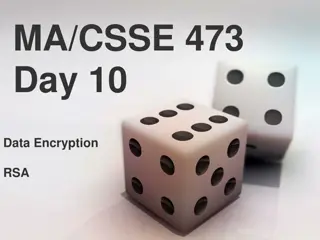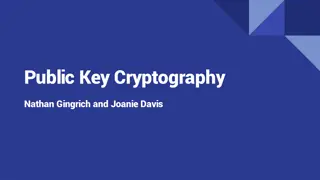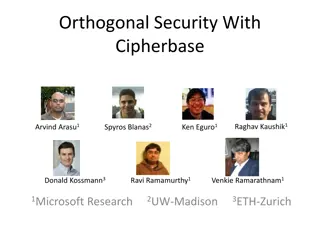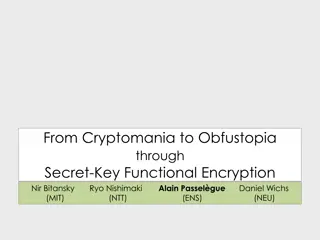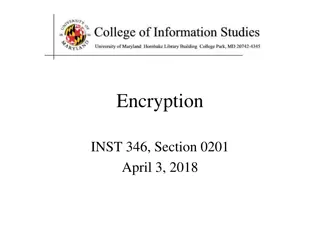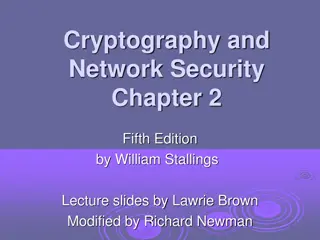Overview of Attribute-Based Encryption Systems
Collection showcases various attribute-based encryption schemes such as Registered Attribute-Based Encryption, Key Exfiltration Problem, and Registration Based Encryption. It also discusses the central authority vs. key curator dynamic, as well as results and improvements in the field. Limitations of certain constructions are also highlighted.
Download Presentation

Please find below an Image/Link to download the presentation.
The content on the website is provided AS IS for your information and personal use only. It may not be sold, licensed, or shared on other websites without obtaining consent from the author.If you encounter any issues during the download, it is possible that the publisher has removed the file from their server.
You are allowed to download the files provided on this website for personal or commercial use, subject to the condition that they are used lawfully. All files are the property of their respective owners.
The content on the website is provided AS IS for your information and personal use only. It may not be sold, licensed, or shared on other websites without obtaining consent from the author.
E N D
Presentation Transcript
Registered Attribute-Based Encryption Susan Hohenberger George Lu Brent Waters David Wu
Attribute Based Encryption [SW05, GPSW06] skfaculty + CS skfaculty + math pk skstudent + CS ctCS AND faculty
Key Exfiltration Problem skfaculty + CS Central Authority Point of Failure skfaculty + math pk msk skstudent + CS
Registration Based Encryption [GHMR18] sk1 ctid1 sk2 pk2 id2 sk3 mpk mpk' mpk No Master Secret!
Trivial RBE sk1 ctid1 sk2 pk2 id2 sk3 mpk mpk' mpk mpk independent of number of users!
Central Authority vs Key Curator Computes compact master keys Internal state compromises security Noninteractive key issuing Computes compact master keys Security holds even with access to curator state (transparent + deterministic!) Requires interaction
Registered Attribute Based Encryption faculty + math mpk ctCS AND faculty
Results Registered Attribute-Based Encryption for bounded users From composite order bilinear groups Monotone boolean formulas policies Registered Attribute-Based Encryption for unbounded users From indistinguishability obfuscation General circuits policies
Improvement from Prior Work [GHMR18, GHM+19, GV20, CES21] Construction 1 Monotone Boolean Formulas Concrete efficiency Black box Identities/Point Functions Large ciphertexts Obfuscation or hash garbling
Limitations [GHMR18, GHM+19, GV20, CES21] Construction 1 Unbounded Users Uniform Random String Linear curator state Bounded Users Structured Reference String Quadratic CRS and curator state
Background Scheme constructed in composite order bilinear groups Composite Order Bilinear
Slotted Aggregation mpk mpk' mpk mpk
ABE in Bilinear Groups [GPSW06,LOS+10] Conjunction Policies wx : x [N] Uw = guw : w U e(g,g) g Encryption: h e(g,g) s hsxUwx s gs Ciphertext: g ht gt Uwt : w S Decryption: e(g,g) s e(g,h)ts e(g,h)tse(g,U (x))ts *Replace additive secret sharing with linear secret sharing to support monotone Boolean formula
ABE in Bilinear Groups [GPSW06,LOS+10] Conjunction Policies wx : x [N] Uw = guw : w U e(g,g) g Encryption: h e(g,g) s hsxUwx s gs gs Ciphertext: g ht gt Uwt : w S Decryption: e(g,g) s e(g,h)ts e(g,U (x))ts e(g,h)tse(g,U (x))ts *Replace additive secret sharing with linear secret sharing to support monotone Boolean formula
ABE in Bilinear Groups [GPSW06,LOS+10] Conjunction Policies wx : x [N] Uw = guw : w U e(g,g) g Encryption: h pk e(g,g) s hsxUwx s gs gs Ciphertext: g ht gt Uwt : w S Decryption: sk e(g,g) s *Replace additive secret sharing with linear secret sharing to support monotone Boolean formula
Roadmap Attribute Based Encryption ABE.pk gr guw : w U 1-User Registered ABE L-User Registered ABE
Cross-Term Cancellation gt1 e(g,U1 )st 2 e( , ) = U2 t U1 t2 U3 t2 e( , ) e(g,U2 )st gt 2 2 gs 2 User 2 gt3 e(g,U3 )st 2 Conceptually similar to techniques used for constructing vector commitments [CF11] or batch arguments [WW22]
Roadmap Attribute Based Encryption ABE.pk gr guw : w U 1-User Registered ABE L-User Registered ABE (Semi-honest Security) L-User Registered ABE (Malicious Security)
Conclusion Defined registered ABE Construct first registered ABE schemes First registered scheme to make black box use of crypto Registered ABE for general circuits Followup Works Registered Functional Encryption from iO [DP23, FFM+23] Registered Predicate Encryption from pairings [FFM+23] Open Questions Large Attribute Universe registered ABE? Generic transformation from X to registered X? Upcoming Work More Asymptotically and Concretely Efficient R-ABE Prime Order Construction Nearly-Linear CRS
Thank you! Read our paper on eprint 2022/1500
